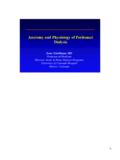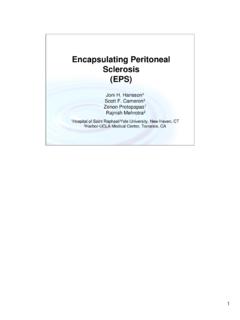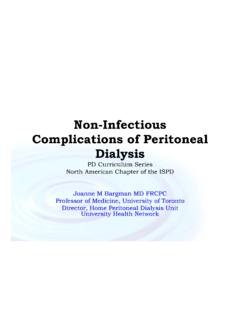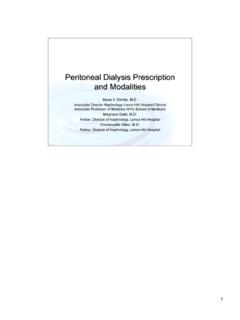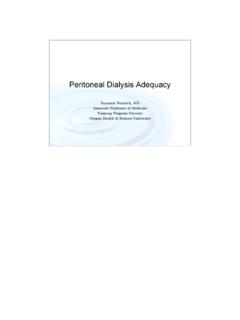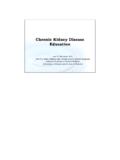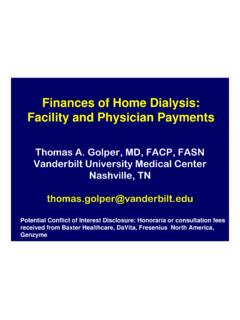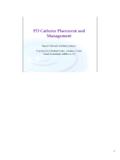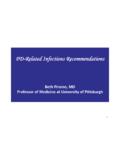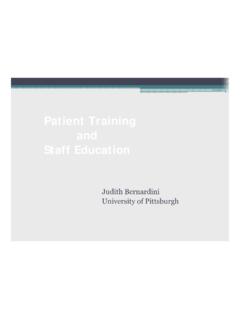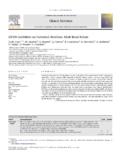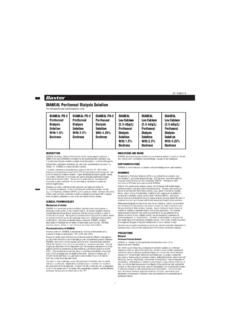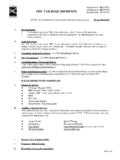Transcription of PD in Special Populations - International Society for ...
1 peritoneal Dialysisin Special PopulationsISPD-NAC Curriculum 2011 Anjali Bhatt Saxena, MD, FASNC linical Assistant Professor of Medicine, Stanford University, Stanford CADirector of peritoneal Dialysis,Santa Clara Valley Medical, San Jose, CA1 Kidney Replacement Therapy:Modality Choice Many patients have a medical contraindication for transplantation Far fewer patients have an absolute medical contraindication for one dialysis therapy over the other The majority of patients could do either Patient preference should play an important role in the choice of dialysis modality 2 Most Patients Are Eligible for PD1. Jager K et J Kidney Dis. 2004;43 Mehrotra et al. Kidney Int. 2005;68 Little et al. Am J Kidney Dis. 2001:37:981-986>1000 ESRD Patients Starting Dialysis% Medically Eligible for PDNetherlands183%83% Most patients are medically eligible for PD.
2 PD has few absolute medical contraindications. In a large Dutch study, only 17% of ESRD patients had a medical contraindication to PD; the most common was previous major abdominal surgery. Many patients in this study had a social contraindication to PD, the most common was an inability to perform PD exchanges by themselves. In a recent study, only 23% of ESRD patients had a medical contraindication to PD, this was consistent with the 17% to 21% seen in studies from other countries. (Jager KJ et al. Am J Kidney Dis. 2004;43:891 899).2At the start of dialysis therapy, the patient s nephrologist completed a structured questionnaire on the process of long term modality selection (Appendix). Although modality choice most often is based on several grounds, the nephrologist was asked what he or she considered the most important reason for the selection of a particular modality(Mehrotra R, et al.)
3 Kidney Int. 2005;68:378 390)3 peritoneal Dialysis in Special Populations :Outline: Elderly Populations Diabetics Obesity Polycystic kidney disease Patients with a history of multiple previous abdominal surgeries Cirrhosis and chronic ascites4 peritoneal Dialysis in the ElderlySpecial Considerations in Geriatric Nephrology Quality vs. quantity of life: quality may be more important to the geriatric patient Avoiding hospitalizations, complications Prefer more time at home with family/friends/hobbies Accumulation of comorbidities occurs with age in all patient groups, and affects survival data regardless of RRT modality Few studies specifically address this age groupPotential advantages of PD in the elderly Increased cardiovascular stability (fewer arrhythmias) Fewer travel requirements to and from center Avoidance of repeated vascular access elderly often have poor target veins, require repetitive vascular procedures avoids chronic venous catheters when AVF/G are unsuccessful Low risk of GI bleeding (no anticoagulation)
4 Conducive to recreational travel Excellent 1-year survivalPatients not normally considered for PD may have reasons to choose this modalityPD in the elderly:potential problems Increased number and complexity of comorbidities in older patients Depression, dementia, impaired vision, and decreased physical and mental activity may impair self-performance of dialysis N. and Oreopoulos DG, Perit Dial Int 20:276-283, 2000 Specific factors affecting PD in elderlyAdvanced age Decreased manual dexterity/chronic arthritis Inability to ambulate/transfer Incapable of performing PD exchanges themselves Lack of social support9 Manual dexterity problems:potential solutions Connection assist devices CyclerManual dexterity problems- potential solutions Adaptive CAPD systemsRotary disc-system for CAPDA ssisted PD in the elderly Social or medical factors can be barriers to self-care dialysis Leading to underutilization of PD in the elderly Home care assistance can allow more patients to receive PD at home Some patients start w/ assisted PD then graduate to self-care PD12 Various models of assisted-PD Family or friend trained as an assistant Automated PD (APD) with two daily nurse visits AM and PM visits to disconnect and connect from cycler, respectively Allows one RN to attend to more than one patient per day APD or CAPD with a home health assistant Employment and training of a dedicated care-giver Assisted living center or Skilled Nurse Facility13 Assisted-PD.
5 Data Healthcare policies supporting assisted PD increase utilization of PD1 Specific funding is available and has been studied in: Belgium, Canada, Denmark, France and Canary Islands Assisted PD does not cost more than in-center HD, even when the cost of the home care provider is taken into account21. Increased utilization of home dialysis, especially in the elderly population , occurred in Canada and also in several European countries after the adoption of formal assisted home dialysis programs. 2. Despite the additional costs of providing caregivers, these assisted peritoneal Dialysis programs reported cost savings with PD (as compared to in center HD) that persisted even after taking into account payments to home care providers; these cost savings were realized because PD itself provides cost savings over chronic hemodialysis of almost $20,000 per patient per : Brown EA, Dratwa M, Povlsen JV.
6 Assisted peritoneal dialysis an evolving dialysis modality. Nephrol Dial Transplant. 22:3091 3092, 2007. Shih YC, Guo A, Just PM, Mujais S. Impact of initial dialysis modality and modality switches on Medicare expenditures of end stage renal disease patients. Kidney Int. 68:319 329, 2005. Oliver MJ, Quinn RR, Richardson EP, Kiss AJ, Lamping DL, Manns BJ. Home care assistance and the utilization of peritoneal dialysis. Kidney (7):673 678, 2007. Renal Data System. Table Counts of incident ESRD patients, by initial mode of therapy: hemodialysis. In: National Institutes of Health, National Institute of Diabetes and Digestive and Kidney Diseases, eds. USRDS 2007 Annual Data Report: Atlas of End Stage Renal Disease in the United States. Bethesda, MD; concerns when using PD in the elderly Higher malnutrition risk Decreased appetite, socio-economic factors, and more comorbidities in this group are contributing factors Must pay close attention to diet and nutritional status Several studies show infection rates to be similar in elderly vs.
7 Non-elderly PD patients, however, infection is associated with greater mortality in the elderlyReferences1. Ho dac Pannekeet. Nephrol Dial 21 [Suppl 2]: ii60 ii62, 20062. Li PK et al. peritoneal Dialysis International , Vol. 27, Supplement 2, 200715PD in the elderly: conclusions PD is not contraindicated in elderly and offers some advantages over in-center HD Home care assistance can allow more elderly ESRD patients to receive PD Mortality appears to be related to increased burden of comorbidities with age, rather than due to modality per se Complication rates between PD and HD in the elderly are similar; peritonitis rates may be somewhat higher in elderly but the reported overall peritonitis rates in elderly are acceptable (less than 1:20 months)REFERENCES:2007: Li, et al. Perit Dial Int. 2007 Jun;27 Suppl 2:S196 201 2007: Yang, et al.
8 Int Urol Nephrol. 2007;39(4):1295 302 2006: Mircescu, et al. Perit Dial Int. 2006 Mar Apr;26(2):266 75 1998: DeVecchi et al. Am J Kidney Dis. 1998 Mar;31(3):479 90. 1997: Back, et al. Adv Perit Dial. 1997;13:158 61. 1993: Suh, et al. Adv Perit Dial. 1993;9:134-7 16 peritoneal Dialysis in DiabeticsDiabetics and ESRD Among all ESRD patients, diabetics fare among the worst, in part due to their high burden of cardiovascular disease PD provides a survival advantage over HD for the 1sttwo years of therapy, possibly in part due to reduced infection rates (high catheter rate in the first year of HD), and better preserved residual kidney function with PDPotential advantages of PD in diabetics Home-based continuous therapy Less dialysis-induced hypotension, coronary ischemia, and arrhythmia; better sustained blood pressure control Better preservation of residual renal function No need for vascular access No systemic heparinization important for patients with significant DM retinopathy and a tendency for retinal hemorrhage Less progressive DM retinopathy**Sato K, Babazono Clin Dialysis, 2000;16:2137 disadvantages of PD in diabetics Glucose absorption from dialysate: Hyperglycemia Weight gain Hypertriglyceridemia peritoneal membrane changes Exposure to advanced glycosylated end products (AGEs) and glucose degradation products (GDPs)Neutral effects of dialysis modality in Diabetics No consistent evidence exists to show that diabetics have more infections (peritonitis or exit site) No consistent evidence exists to prove a higher incidence of EPS in diabetic vs.
9 Non-diabetics on PDEPS= encapsulated peritoneal sclerosis21PD in diabetics: outcome studies Large disparity in the results of studies evaluating outcomes of diabetics on PD versus HD Some show benefits of one dialysis modality or the other, some show no difference Large heterogeneity in study design, patient background (including age, dialysis vintage, comorbidities) and statistical methods used22 General findings of survival studies:PD in diabetics Non-diabetics and younger diabetics (18-44y) have superior or equivalent survival rates with PD compared with HD In the , diabetic ESRD patients > 45y have better survivalwith HD than PD, whereas in Canada and Denmark, there is no survival difference between PD and HD in this group PD offers an equal or lower mortality rate overall compared to HD in the first 1-2 years of dialysis therapy; thereafter the results vary by subgroup In addition to DM status, both age and the presence of comorbidities influence the effect of dialysis modality on survival More contemporary cohort studies show survival rates are improving in PD whereas they are stagnant in HDPD is not contraindicated in DMVonesh et al.
10 Kidney International (2006) 70, S3 S1123 Special considerations for diabetics on PDGokal R et al. Kidney International (2002) 62, S62 S71 Limit glucose absorption as much as possible:-limit use of hypertonic solutions-consider Icodextrin for the long dwell, especially in rapid transporters, due to its superior UF efficiency (see next slide)24 Ultrafiltration Efficiency: volume of ultrafiltration achieved per gram of carbohydrate absorbed: Icodextrin is more efficientHolmes and Mujais Kid Int 70: S104, 2006 Comparison of UF efficiency with dextrose compared with Icodextrin for the long dwell in CAPDA bsence of hyperglycemic and hyperinsulinemic effects when using Icodextrin during the long dwellGokal R et al. Kidney International (2002) 62, S62 S7126 Improved metabolic control and volume status with Icodextrin RCT comparing PD patients receiving either Icodextrin (ICO)or glucose-based(GLU) PD solution for the long dwell 12 month follow-up Liberal use of and dextrose solution allowed in both groups in order to meet target BP and edema status Monthly measurements of labs and clinical parametersPaniagua R.
